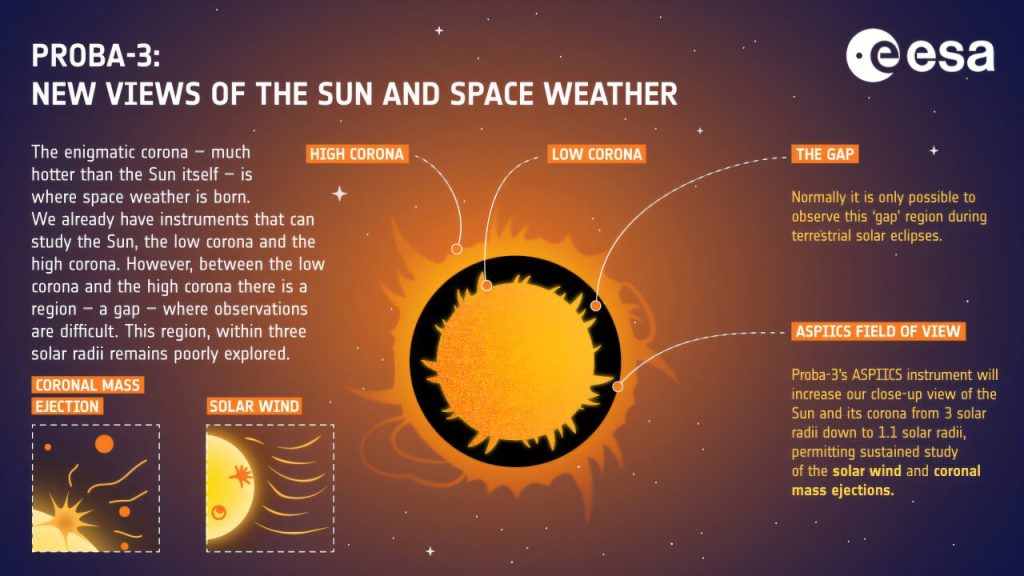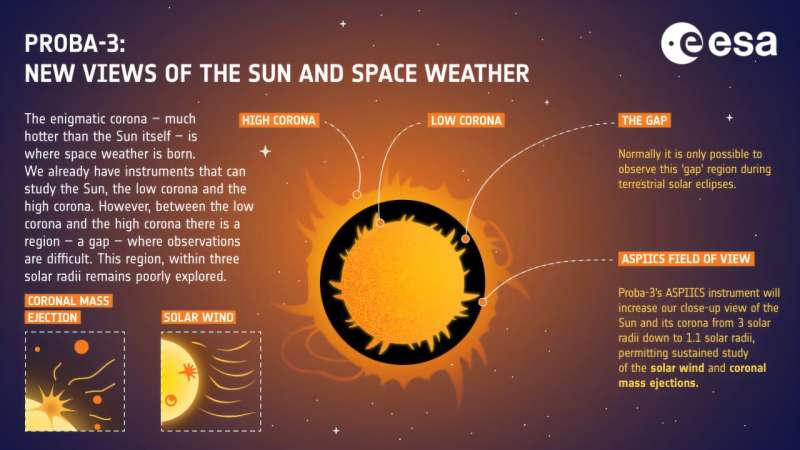
Five space mysteries Proba-3 will help solve (Image Credit: Phys.org)

ESA’s Proba-3 will be the first mission to create an artificial total solar eclipse by flying a pair of satellites 150 meters apart. For six hours at a time, it will be able to see the sun’s faint atmosphere, the corona, in the hard-to-observe region between the sun’s edge and 1.4 million kilometers from its surface. This new technology combined with the satellite pair’s unique extended orbit around Earth will allow Proba-3 to do important science, revealing secrets of the sun, space weather and Earth’s radiation belts.
Proba-3, short for “Project for On-Board Autonomy 3,” is the fourth in a series of in-orbit demonstration missions which test out new technologies. The millimeter precision with which the pair of satellites will position themselves in space has never been done before.
Let’s dive into the top five space science mysteries that this mission will investigate.
1. Why is the solar corona so much hotter than the sun itself?
We all know the sun is hot, but it is still a mystery how material in the sun’s outer atmosphere, the solar corona, can reach million-degree temperatures. The visible surface below it, called the photosphere, is just 4500–6000 °C.
Rather than being a real surface, the photosphere is the layer of the sun from which visible light can escape. Below it, light emitted from atoms in the sun’s hot, dense interior is almost immediately re-absorbed by other atoms. Light can be trapped inside the sun for a long time before it can escape from the photosphere through the less dense charged gas (plasma) above.
Moving out into the corona, which is both less dense and further from the sun’s core, you would expect to find lower temperatures. Instead, it gets around two-hundred times hotter!
Proba-3 will tackle this mystery by studying the solar corona closer to the sun’s surface than any ‘coronagraph’ before it. By blocking out the sun’s direct light with one spacecraft, the other spacecraft will be able to see the faint visible light coming from the corona down to just 70 000 km above the sun’s surface.
The coronagraph is Proba-3’s main science instrument. It is called ASPIICS, which stands for Association of Spacecraft for Polarimetric and Imaging Investigation of the Corona of the sun.
One thing ASPIICS will hunt for is waves moving through the loops and plumes of plasma in the corona. This kind of movement is a likely cause for the corona’s high temperatures. The coronagraph will be able to capture these small-scale, fast movements by imaging the inner corona as fast as every couple of seconds.
Additionally, the coronagraph can show us which parts of the sun’s corona are hotter than others by using different light filters. Imaging in white light, the instrument sees where the glowing plasma (of all temperatures) is concentrated and how it moves around. These images can be compared to those taken through a green light filter, which selectively captures light sent out by particularly hot particles in the corona.
2. What accelerates the solar wind?
The solar wind is the continuous stream of plasma sent out by the sun, mostly made up of electrons, protons and alpha particles. When the solar wind collides with Earth’s magnetic field it can produce auroras—the northern and southern lights.
Just like wind on Earth, solar wind can be fast or slow, smooth or gusty. It comes in two main types, which differ not only in wind speed but also in composition and source region.
“Slow” solar wind—which still reaches Earth with speeds up to 500 km/s, or 1.8 million km/h—is made up of particles that resemble the makeup of the sun’s outer atmosphere or corona. While the details remain elusive, this type of solar wind is known to be connected to active sunspot regions on the sun which also produce solar flares and eruptions.
Proba-3’s ASPIICS coronagraph will investigate how the twisted and concentrated magnetic field lines coming from sunspots interact with the magnetic field further out. While it cannot detect this field directly, it will see the glowing plasma in the corona which follows along magnetic field lines and disturbances therein. By hunting for ‘blobs’ of slow solar wind, it can track how and where the wind gets pushed out.
“Fast” solar wind can reach speeds of more than two million kilometers per hour and is composed of a particle mix more closely resembling that of the sun’s surface. This type of wind is known to come from magnetic structures called coronal holes—regions where the sun’s magnetic field does not turn back down into the sun. Plasma can flow outward along these ‘open’ magnetic field lines, creating solar wind.
But the question remains: how does fast solar wind reach such high speeds? To solve this mystery, Proba-3 will search for jets and waves including ‘magnetic switchbacks’ thought to give solar wind a magnetic push. ASPIICS will reveal how plasma moves through the corona from right near the sun’s surface to around 1.4 million km further out.
Discover the latest in science, tech, and space with over 100,000 subscribers who rely on Phys.org for daily insights.
Sign up for our free newsletter and get updates on breakthroughs,
innovations, and research that matter—daily or weekly.
3. How does the sun fling out material in coronal mass ejections?
Solar wind is one type of space weather, but what we really need to watch out for are the larger, more powerful solar storms. Coronal mass ejections (CMEs) are huge bubbles of charged particles (plasma) threaded with magnetic field lines. CMEs are often—but not always—launched at the same time as bursts of electromagnetic radiation known as solar flares.
When Earth gets hit by a CME, this can deform Earth’s protective magnetic field and cause a geomagnetic storm. These storms can affect satellites, disrupt navigation systems, cause power outages, and bring auroras to lower latitudes.
Fast-moving CMEs can also create shockwaves that accelerate protons or other particles around the sun to extremely high speeds. These ‘solar energetic particles‘ can damage spacecraft and pose a risk to astronauts outside Earth’s protective atmosphere.
By being able to see what happens in the solar corona very close to the sun’s surface, Proba-3 will reveal what happens leading up to a CME, how they erupt, how they expand outwards and how they interact with other structures and activity around the sun. It will see this part of the sun’s atmosphere for hours at a time and better than any coronagraph before it.
4. How do electrons trapped in Earth’s radiation belts behave?
Space around Earth constantly has particles racing through it, either coming from the sun, slingshotted to us from elsewhere in the solar system, or reaching us from interstellar space. Thankfully, we are protected from these by Earth’s protective atmosphere and magnetic field, but this same field traps charged particles in rings around Earth known as the Van Allen radiation belts.
These fast-moving, high-energy particles pose risks to devices in space. They can disrupt onboard measurements and memories, or even cause permanent damage, while also posing potential danger to astronauts.
Proba-3’s extended, elliptical orbit brings if from 600 km above Earth’s surface all the way out to 60 530 km. This means that in every 19.7-hour orbit it passes twice through both the inner and outer radiation belts surrounding our planet. There are other Earth-orbiting missions that traverse both belts, but Proba-3 is unique in crossing an unusually large portion of them.
With its 3D Energetic Electron Spectrometer (3DEES) instrument, Proba-3 will measure the number, direction of origin and energies of electrons in Earth’s radiation belts. This is the first time that the energy and fluxes of high-energy electrons will be measured at the same time across six different directions spanning a 180° field of view.
3DEES will reveal the behavior of Earth’s radiation belts under normal conditions, but it will also see how they are affected by space weather, including the previously mentioned solar wind and coronal mass ejections.
5. How much does the sun’s energy output change over time?
The sun shines every day, but some days it shines more than others. Within a year, depending on Earth’s distance to the sun, the total solar irradiance reaching Earth can vary as much as 6%. But how much the sun radiates also changes depending on how active it is, with changes of around 0.1% taking place over the roughly 11-year solar cycle.
It is still a matter of scientific debate how much the sun’s energy output has changed over longer time periods (100–1000 years). While recent climate change is certainly caused by human activities, it is possible that the sun had a part to play in past climatic changes such as the cooling during the Little Ice Age (c. 1300–1850). Could the sun be more changeable than recent records show?
The sun is responsible for more than 99.9% of the energy available at Earth’s surface, and even small changes can have a big impact on processes that shape Earth’s climate. Knowing the total solar irradiance is important for accurate climate modeling.
To improve and extend our monitoring of the sun, Proba-3’s “Occulter’ spacecraft will continuously measure the sun’s energy output using its Digital Absolute Radiometer (DARA) instrument. DARA is designed to minimize unwanted straylight entering it, it can calibrate itself, and it should be able to measure more frequently thanks to a faster control system.
Another DARA—the exact same instrument—is already flying through space on the Chinese FY-3E weather satellite, launched in 2021 and flying around 800 km above Earth’s surface.
The main difference between Proba-3’s DARA and previous radiometers will be its very elongated orbit, which will carry it out to 60,530 km above Earth’s surface. The larger distance from Earth means the instrument’s space environment is cleaner, with less scattered light. This will allow Proba-3 to measure variations in the solar irradiance with high accuracy and precision.
Provided by
European Space Agency
Five space mysteries Proba-3 will help solve (2024, December 3)
retrieved 4 December 2024
from https://phys.org/news/2024-12-space-mysteries-proba.html
part may be reproduced without the written permission. The content is provided for information purposes only.






